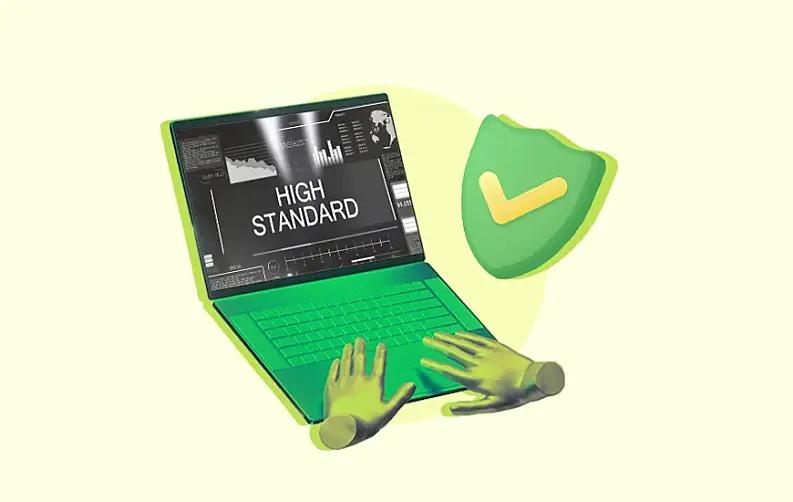
- What is Mandatory Access Control | An Overview
- Understanding the Types of Access Control: MAC, DAC, and RBAC
- The Role of Discretionary Access Control (DAC) in Security Frameworks
- Advantages of Mandatory Access Control Over Other Access Control Models
- Role-Based Access Control (RBAC): Complementing MAC in Security Strategies
- Key Considerations When Implementing MAC in Sensitive Environments
- Best Practices for Deploying Mandatory Access Control Systems
-
Weighing the pros and cons of Mandatory Access Control
- Future Trends in Access Control: Enhancing Security in High-Risk Areas
- Conclusion

In today's world, places with super-tight security are always at risk from different threats. It's super important for them to have strong security measures to protect their important stuff and keep sensitive info safe.
One big part of this protection plan is using something called Mandatory Access Control (MAC) systems. These systems let organizations control who gets access to what in a detailed way, which helps stop unauthorized access.
This article explores what is mandatory access control and the best ways to set up MAC systems in high-security places. We'll discuss the problems and the right strategy for mandatory access control. By learning these tips and tricks, organizations can make their security even more vital in tricky situations.
What is Mandatory Access Control | An Overview
Mandatory Access Control (MAC) is a crucial security measure that limits user access based on preset rules and policies. The mandatory access control model is widely used in highly secure environments like government agencies, military institutions, and financial organizations where protecting sensitive information is paramount.
In MAC systems, administrators define access controls instead of individual users. These controls determine users' actions and resources they can access. This centralized approach ensures consistent security across the entire system.
Deploying MAC necessitates thorough preparation, considering user responsibilities, data categorization, and potential risks. The aim is to establish a protected setting where authorized persons can obtain sensitive information or carry out specific duties.
Understanding the Types of Access Control: MAC, DAC, and RBAC
Access control is a crucial aspect of security in high-risk environments. Organizations can implement several types of access control methods to protect their sensitive data and resources.
First, there's Mandatory Access Control (MAC). In MAC, the boss decides how sensitive each person's access level is based on their job or how much they need to know. Users can't change these access levels themselves; they must stick to the boss's words. This ensures a clear hierarchy and stops anyone from sneaking into important info.
Then there's Discretionary Access Control (DAC). Here, users have more freedom to decide who can access their stuff. They can permit others, like making someone an owner or giving them different access levels. But this freedom also means a higher risk, as decisions might only sometimes match up with what's best for security.
Lastly, there's Role-Based Access Control (RBAC). This method gives access based on a person's role in the organization, not just who they are. So, someone's access depends on their job or responsibilities. RBAC makes things simpler to manage and reduces the chance of mistakes while ensuring people can do what they need to do.
Understanding these different ways of controlling access helps organizations pick the best one for their needs, especially in places where security is a big deal.
The Role of Discretionary Access Control (DAC) in Security Frameworks
Discretionary Access Control (DAC) is a big part of keeping things safe in computer systems. DAC lets organizations decide who can see what information and what they can do. With DAC, the person who owns the system has the final say on who can see what. They can give or remove access rights to other users as they see fit. This gives users a lot of freedom to control their stuff. However, if it needs to be done carefully, it can also make the system vulnerable to attacks.
There is a huge difference between mandatory and discretionary access control. DAC has benefits, like making things easy for users and giving them much control. However, in places where security is super important, like banks or government agencies, they might need something stricter, like mandatory-based access control. This ensures that only the right people can enter the system, keeping everything safer.
In summary, DAC is great for giving users control, but it's essential to consider how safe it needs to be. Sometimes, stricter measures like MAC might be needed to keep everything secure, especially in high-security places.
Advantages of Mandatory Access Control Over Other Access Control Models
Top cybersecurity companies and other firms employ the MAC model for its exceptional security capabilities. Some of the key advantages of MAC are discussed below.
Enhanced Security:
Mandatory access control implementation keeps things safe on computers. It's better than other ways because it's strict about who can do what. With MAC, only people who are allowed can get to important stuff. This makes it hard for bad people to mess with things or steal information.
Granular Control:
A key role of mandatory access control is letting people in charge control who can do what very precisely. Everyone gets exceptional security and can only do things that match their level. This ensures nobody can access things they're not supposed to or accidentally share secret information.
Protection against Insider Threats:
One good thing about the mandatory access control model is that it stops bad things from happening inside a company. It only gives people access to what they need for their job. This makes it harder for employees to do bad things or secretly share secrets.
Easier Compliance Management:
Using mandatory-based access control makes it easier for companies to follow rules about keeping information safe. This is important for places that have strict rules like HIPAA or GDPR. MAC clarifies what's allowed and ensures everyone follows the rules.
To sum up, MAC is an excellent way to keep computers safe. It's strict about who can do what stops terrible things from happening inside companies and helps companies follow essential rules. It's like a strong shield protecting critical information.
Role-Based Access Control (RBAC): Complementing MAC in Security Strategies
Now that we know the role of mandatory access control, let's understand how RBAC complements it.
RBAC helps by giving specific permissions based on the roles people have in the organization rather than dealing with each person's permissions separately. RBAC helps reduce the confusion and hassle of individually managing access rights. Instead of getting into the nitty-gritty of who can do what, administrators can assign permissions based on job roles, making things more straightforward and less likely to go wrong.
When we combine RBAC with Mandatory Access Control (MAC), things get even better. MAC sets up strict rules based on how important a person's job is and what kind of stuff they need to access.
However, when we add RBAC to the mix, administrators can make broader rules for different groups of users based on their roles. This saves a lot of time and effort for everyone involved. One significant benefit of using both RBAC and MAC together is that it helps us make sure that essential tasks are divided among different people. This way, if something goes wrong with one person, it doesn't affect everything. It's like having a safety net to catch any problems before they become big.
So, by using RBAC alongside MAC, we're making access management more straightforward and our systems more secure by streamlining things and ensuring that everyone only has access to what they need.
This is especially important in places where security is a big concern.
Key Considerations When Implementing MAC in Sensitive Environments
When implementing Mandatory Access Control (MAC) in sensitive environments, there are several key considerations to keep in mind:
1. The granularity of Access Controls:
One big thing to consider with MAC is ensuring only the right people can get to certain things. This means being specific about who can access what. By doing this, organizations can stop people who should be looking at something other than specific information from getting to it. It's like building a solid wall to keep out the bad guys.
2. User Awareness and Training:
Another important part is ensuring everyone knows the rules and gets the right training. Employees need to understand what they can and can't do regarding important information. Regular training helps everyone stay on top of things and ensures they know how to keep everything safe.
3. Regular Auditing and Monitoring
Keeping an eye on things is super important, too. Organizations need to check for any weird stuff happening with their information. This means looking at records and checking systems regularly. Finding problems early helps stop them from getting worse.
4.Secure Configuration Management:
Lastly, it's crucial to keep everything set up securely. This means ensuring all the software and settings are up-to-date and safe from hackers. By doing this, organizations can ensure their systems are robust against new threats.
Best Practices for Deploying Mandatory Access Control Systems
Now that we know what is mandatory access control, let’s have a look at the best practices to implement it.
You must do it right when you set up a super-safe computer system called MAC in high-security places. This means following some crucial rules to ensure the system works well and keeps out people who should be elsewhere.
First off, you've got to make clear rules about security. Before you even start using MAC, it's essential to decide exactly who should be allowed to get into different parts of the system and what they can do there.
Then, you need to keep the system up-to-date and fix any problems. This helps keep the system robust and stops terrible guys from sneaking in through weaknesses.
Another big thing is keeping your keys safe. These are like secret codes that let the system work properly. You must use robust codes and ensure only the right people can access them.
Following these simple rules ensures your system stays safe from sneaky insiders and outside attacks. This way, you can keep things running smoothly, even in places where security is super important.
Weighing the pros and cons of Mandatory Access Control
| Features | Pros | Cons |
|---|---|---|
| 1. Security Level | Ensures high security with central authority access | Can be too restrictive, limiting access to some legitimate users |
| 2. Flexibility | Ensures uniform security measures as policies are centrally managed | Users have limited accessibility to change permissions and controls |
| 3. Scalability | Best-suited for large organizations with a clear structure and hierarchy | Scalability requires careful planning to avoid overly restrictive policies |
| 4. Costs | Potentially reduces long-term costs related to data breaches | Initial management and ongoing expenses can be resource-heavy |
| 5. Adaptability | Effective in an environment where security is a paramount concern | Adapting to evolving security requirements can be slow and challenging |
Future Trends in Access Control: Enhancing Security in High-Risk Areas
Technological progress is driving the creation of advanced access control systems. Exciting developments in the pipeline could bolster security in high-risk locations.
Biometric authentication methods like fingerprint, eye scan, and facial recognition may supplant conventional keys and passwords, providing a more secure and individualized way to authorize entry.
Moreover, incorporating artificial intelligence (AI) could empower computers to independently acquire knowledge and solve problems, fundamentally transforming the potential of access control systems.
In the future, access control systems might use AI to look at a lot of information and spot any signs of danger. This way, they can become even better at stopping people who shouldn't be there.
Nowadays, many devices like cameras and sensors can connect to the internet. In the future, these devices might work together to keep places safe. For example, if a sensor notices something strange, it could tell a camera to start recording.
Using these new ideas, places with tight security can ensure their things and people are safe from harm. It's like being a step ahead of bad stuff using clever technology.
Conclusion
While implementing Mandatory Access Control (MAC) is a cornerstone for securing high-security environments, it's just one aspect of a comprehensive cybersecurity strategy. To further fortify your defenses, exploring additional cybersecurity tips and tricks can provide valuable insights and practices.
As technology evolves and threats become more sophisticated, the principles underlying MAC will continue to be a critical tool for cybersecurity defenses. These will ensure that sensitive information remains protected in an increasingly digital world.
As technology evolves and threats become more sophisticated, the principles underlying MAC will continue to be a critical tool for cybersecurity defenses. These will ensure that sensitive information remains protected in an increasingly digital world.
Frequently Asked Questions
-
What is Mandatory Access Control (MAC)?
-
Why is mandatory access control used?
-
How does mandatory access control work?
-
What are the two key elements of mandatory access control?
-
What is the best mandatory access control example in the real world?



















